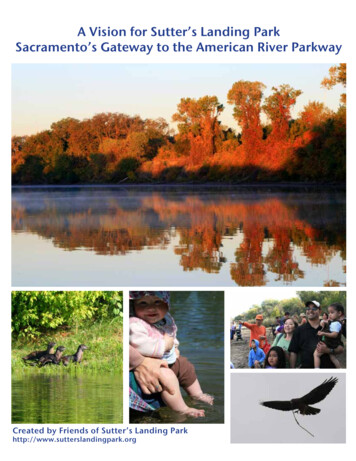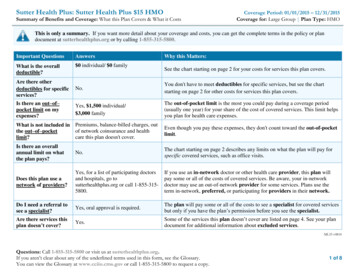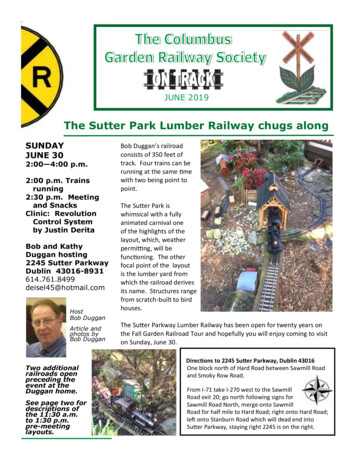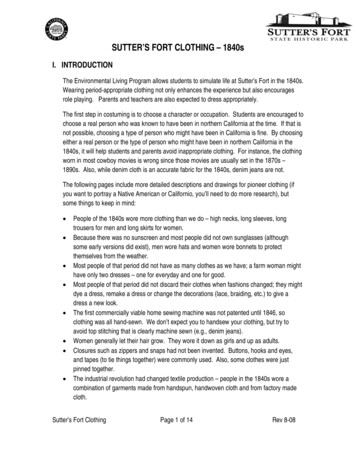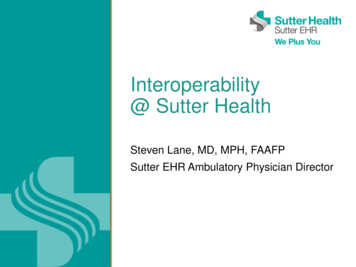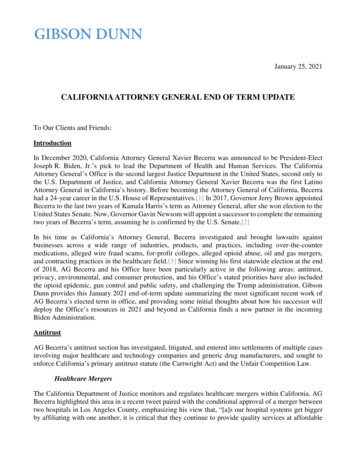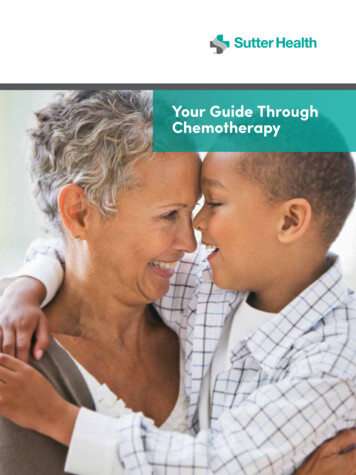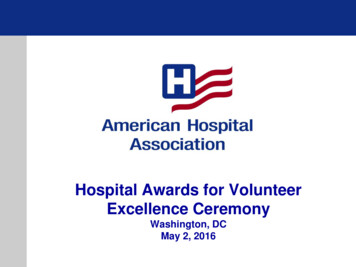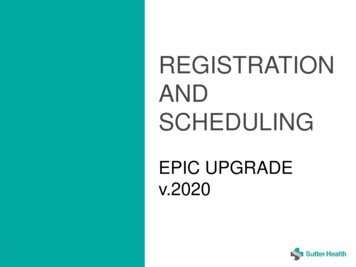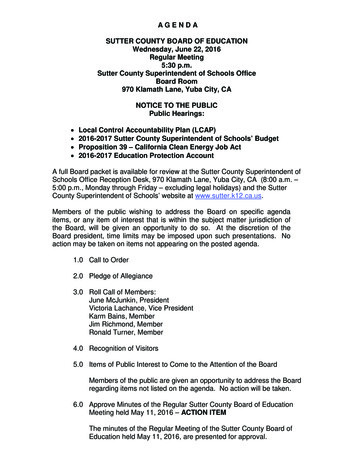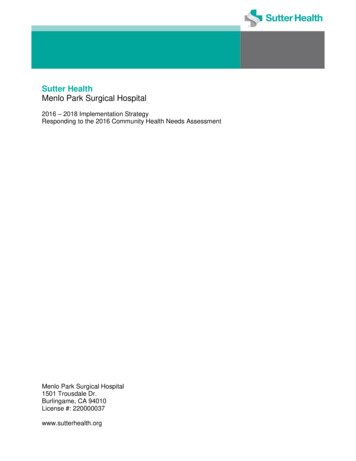
Transcription
Sutter HealthMenlo Park Surgical Hospital2016 – 2018 Implementation StrategyResponding to the 2016 Community Health Needs AssessmentMenlo Park Surgical Hospital1501 Trousdale Dr.Burlingame, CA 94010License #: 220000037www.sutterhealth.org
Table of ContentsAbout Sutter Health . 32016 Community Health Needs Assessment Summary . 4Definition of the Community Served by the Hospital . 42016 – 2018 Implementation Strategy . 6Oral/Dental Health . 6Needs Menlo Park Surgical Hospital Plans Not to Address . 72
IntroductionThe implementation strategy describes how Menlo Park Surgical Hospital (MPSH) a Sutter Healthaffiliate, plans to address significant health needs identified in the 2016 Community Health NeedsAssessment (CHNA). This document describes how the hospital plans to address identified needs incalendar (tax) years 2016 through 2018.The 2016 CHNA and the 2016 - 2018 determined priorities were reviewed by the hospital to understandand address community health needs, and in accordance with the Internal Revenue Service (IRS)regulations pursuant to the Patient Protection and Affordable Care Act of 2010.The implementation strategy addresses the significant community health needs described in the CHNAthat the hospital plans to address in whole or in part. The hospital reserves the right to amend thisimplementation strategy as circumstances warrant. For example, certain needs may become morepronounced and merit enhancements to the described strategic initiatives. Alternately, otherorganizations in the community may decide to address certain community health needs, and the hospitalmay amend its strategies and refocus on other identified significant health needs. Beyond the initiativesand programs described herein, the hospital is addressing some of these needs simply by providinghealth care to the community, regardless of the patients’ ability to pay.MPSH welcomes comments from the public on the 2016 Community Health Needs Assessment and 2016– 2018 implementation strategy. Written comments can be submitted: By emailing the Sutter Health System Office Community Benefit department atSHCB@sutterhealth.org; Through the mail using the hospital’s address 1501 Trousdale Dr. Burlingame, CA 94010 andattention to Community Benefit Department; and In-person at the hospital’s Information Desk.About Sutter HealthMPSH is operated by Sutter Health as a not-for-profit network of hospitals, physicians, employees andvolunteers who care for more than 100 Northern California towns and cities. Together, they provide anintegrated, seamless and affordable approach to caring for patients.The hospital’s mission is to enhance the well-being of people in the communities it serves through a notfor-profit commitment to compassion and excellence in health care services. .Over the past five years, Sutter Health has committed nearly 4 billion to care for patients who couldn’tafford to pay, and to support programs that improve community health. Our 2015 commitment of 957million includes unreimbursed costs of providing care to Medi-Cal patients, traditional charity care andinvestments in health education and public benefit programs. For example: In 2015, Sutter Health invested 712 million more than the state paid to care for Medi-Calpatients. Medi-Cal accounted for 20 percent of Sutter Health’s gross patient service revenues in2015. Sutter Health hospitals proudly serve more Medi-Cal patients in our Northern Californiaservice area than any other health care provider. As the number of insured people grows, hospitals across the U.S. continue to experience adecline in the provision of charity care. In 2015, Sutter Health’s investment in charity care was 52 million. Throughout our health care system, we partner with and support community health centers toensure that those in need have access to primary and specialty care. We also support children’shealth centers, food banks, youth education, job training programs and services that providecounseling to domestic violence victims.3
Every three years, Sutter Health hospitals participate in a comprehensive and collaborative CommunityHealth Needs Assessment, which identifies local health care priorities and guides our community benefitstrategies. The assessments help ensure that we invest our community benefit dollars in a way thattargets and address real community needs.For more facts and information about MPSH visit www.sutterhealth.org.2016 Community Health Needs Assessment SummaryIn accordance with legislative requirements, MPSH participated in the Healthy Community Collaborativeof San Mateo County (HCC) to conduct a CHNA of its service area, San Mateo County (SMC). HCCwas formed in 1995 as a subcommittee of the San Mateo County Hospital Consortium. It is a 10 memberorganization consisting of representatives from nonprofit hospitals, County Health Department andHuman Services, public agencies, and community based organizations. In 2015, HCC engaged AppliedSurvey Research (ASR) to conduct the 2016 CHNA on its behalf. ASR obtained primary and secondarydata from a variety of sources, including community input and focus groups to assess community healthtrends. The mission of the collaborative is to promote the health and well-being of residents living in SanMateo County by identifying and addressing community health needs.The full 2016 Community Health Needs Assessment conducted by MPSH is available atwww.sutterhealth.org.Definition of the Community Served by the HospitalSpreading over 744 sq miles, San Mateo County is located on the San Francisco Peninsula. It contains20 cities and towns, and is bordered by the City of San Francisco on the north, San Francisco Bay on theeast, Santa Clara County of the south, and the Pacific Ocean on the west. SMC is a mix of urban andsuburban industrial, small business, and residential use. The Coastal area is renowned for its significantagricultural, fishing, small business and tourism.According to the US Census the estimated population in 2014 was 744,581. The County’s population isaging and the trend is expected to increase over the next decades. Less than one quarter (24%) of theresidents are under the age of 20, while 35% are between the ages of 20 and 44, and the rest (41%) ofthe residents are over the age of 44. Those aged 60 and older will increase from 20.0% (in 2014) to30.9%. By 2050, the Asian/Pacific Islander and Hispanic seniors will comprise the largest proportion ofseniors.SMC is also becoming increasingly diverse. The US Census estimates that by 2050, the white populationwill drop from 43% to 22%, the Latino population will increase from 26% to 38%, the Asian/PacificIslanders will increase from 26% to 32% and that the African American population will experience a slightincrease from 3% to 4%. Currently, the child population is more diverse than the adult population.One in ten children aged 18 and younger live below the Federal Poverty Level (FPL) and 8% of all SMCindividuals live below FPL. According to the 2014 Family Self-Sufficiency Standard (FSSS), a singleparent with two children living in SMC must earn approximately 97,200 annually to meet the family’sbasic needs – the equivalent of five full-time minimum-wage jobs in SMC.Between 2013 and 2014, there was a 12% drop in the number of uninsured Californians aged 18-64years old according to data cited by the California Healthcare Foundation. The San Mateo County HealthSystem reported that as of March 2016 (based on 2014 census data) an estimated 62,000 countyresidents had enrolled in health insurance coverage, made possible by ACA. However, an estimate of50,000 adults remain uninsured in SMC, approximating an uninsured rate of 7%. SMC no longer insuresundocumented immigrants because they are eligible for Covered CA and without SMC’s subsidy the careoffered through Covered CA is unaffordable for most undocumented immigrants.4
Significant Health Needs Identified in the 2016 CHNAThe following significant health needs were identified in the 2016 CHNA:1. Health Care and Delivery2. Oral/Dental HealthCriteria used to identify health needsTo identify San Mateo County’s Health needs, the 2016 CHNA followed a series of steps show in thegraphic below:Gathered & reviewed data on more than 120 health indicators using:.,.,.,.,-Re ports p r ovide d by t he San Mareo County Health Department(including the 2013 SMC CNA)Healthy People 2020 objectivesOthe r widely acce pted statistical data sourcesQualitative data from focus gro u ps and key informant int e rviewsCreated list of health issues that qualify ashealth needs per aiteria:././.'Must fit the definition of a health needMust be indicated by mor e than one data sourceMust not meet bench mark (HP2020/ state average)Used additional standards toprioritize the health needsPrioritized HealthNeedsHospital Prioritization ProcessFollowing the HCC review of countywide health needs, MPSH chose a set of criteria to use in a formatprioritization of the list of 21 health needs. The criteria were:Clear disparities or inequitiesSeverity of need: Magnitude /ScalePrevention opportunityMultiplier effect5
2016 – 2018 Implementation StrategyThe implementation strategy describes how MPSH plans to address significant health needs identified inthe 2016 Community Health Needs Assessment and is aligned with the hospital’s charitable mission. Thestrategy describes: Actions the hospital intends to take, including programs and resources it plans to commit; Anticipated impacts of these actions and a plan to evaluate impact; and Any planned collaboration between the hospital and other organizations in the community toaddress the significant health needs identified in the 2016 CHNA.The Implementation Strategy serves as a foundation for further alignment and connection of other MPSHinitiatives that may not be described herein, but which together advance commitment to improving thehealth of the communities it serves. Each year, MPSH’s programs are evaluated for effectiveness, theneed for continuation, discontinuation, or the need for enhancement. Depending on these variables,programs may change or continue.The prioritized significant health need the hospital will address is:1. Oral/Dental HealthOral/Dental HealthName ofprogram/activity/initiativeDescriptionRavenswood Family Health CenterRavenswood Family Health Center (RFHC) is a federally qualified healthcenter headquartered in the low-income East Palo Alto area of SMC. Itprovides a comprehensive scope of health care services, includingdentistry, family practice, ultrasound, x-ray, lab, health education andprevention.The dental clinic, Ravenswood Family Dentistry (RFD), serves as a criticalaccess point to comprehensive oral health care services for low-incomechildren, families, and individuals. Its 4,800 sq. ft. dental clinic is among thefirst of its kind. It has 14 dental operatories. RFD houses four pediatric oralprevention treatment chairs, five adult chairs, and three oral surgery quietrooms. In addition, its pediatric clinic offers two integrated oral healthprevention operatories to serve children on the same day as their medicalvisit.Ravenswood patient population experience a combination ofsocioeconomic challenges and health disparities. Among its patients, 97%are from households with incomes 200% and below the federal povertylevel (FPL) and live in a place where population density is three timeshigher than neighboring communities. 36% of their patients are uninsuredand 64% are enrolled in public health coverage programs (such as MediCal, Medicare, and San Mateo County Access and Care for Everyone(ACE)). The majority of their patients are ethnic minorities (97%)—including72% Latino, 7% African American, and 7% Native Hawaiian or PacificIslander. Furthermore, 71% of the patients are served in a language otherthan English with Spanish and Tongan being the most common languages.MPSH aims to continue its support by partially funding the operations of thedental clinic.6
GoalsAnticipated OutcomesPlan to EvaluateMetrics Used to Evaluatetheprogram/activity/initiativeFurther increase access to a continuum of oral health care services for theunderserved, low-income children and youth, and those with special needs.1: Enhanced oral health education.2: Improved access to preventive dental care3: Increased access to oral health care services.4: Enhanced integration of oral health and primary care.5: Increased access to dental rehabilitation servicesRavenswood will track electronic dental records (Dentrix) andconduct regular process evaluations.They will forward to MPSH a yearly final report describing progresstowards goals, objectives and outcomes using the metricsdescribed below.Ravenswood to meet or exceed the following annual metrics:1800 of patients served, including those with special needs.14185 Number of visits provided345 Number of oral surgery70 oral surgery operations under general anesthesiaNeeds Menlo Park Surgical Hospital Plans Not to AddressNo hospital can address all of the health needs present in its community. MPSH is committed to servingthe community by adhering to its mission, using its skills and capabilities, and remaining a strongorganization so that it can continue to provide a wide range of community benefits. The implementationstrategy does not include specific plans to address the following significant health needs that wereidentified in the 2016 Community Health Needs Assessment:1. Alzheimer’s Disease and Dementia - Indirectly2. Arthritis - Other organizations are better equipped to address this need3. Behavioral Health - Other organizations are better equipped to address this need4. Birth Outcome - Other organizations are better equipped to address this need5. Cancer - Other organizations are better equipped to address this need6. Childhood Obesity - Other organizations are better equipped to address this need7. Climate Change - Other organizations are better equipped to address this need8. Communicable diseases - Other organizations are better equipped to address this need9. Diabetes - Indirectly10. Emotional Well Being - Other organizations are better equipped to address this need11. Fitness, Diet & Nutrition - Other organizations are better equipped to address this need12. Healthcare access & delivery - Indirectly13. Heart disease and stroke - Indirectly14. Housing and Homelessness - Other organizations are better equipped to address this need15. Income and Employment - Other organizations are better equipped to address this nee16. Respiratory conditions - Other organizations are better equipped to address this need7
17. Sexually Transmitted Diseases - Other organizations are better equipped to address this need18. Transportation and Traffic - Other organizations are better equipped to address this need19. Unintended Injuries - Other organizations are better equipped to address this need20. Violence and Abuse - Other organizations are better equipped to address this needApproval by Governing BoardThe implementation strategy was approved by the Sutter Health [INSERT: VALLEY AREA, BAY AREA,COAST HOSPITAL OR KAHI] Board on [INSERT: DAY, MONTH, YEAR].8
Sutter Health . Menlo Park Surgical Hospital . 2016 - 2018 Implementation Strategy Responding to the 2016 Community Health Needs Assessment . Menlo Park Surgical Hospital 1501 Trousdale Dr. Burlingame, CA 94010 . License #: 220000037 . www.sutterhealth.org . www.sutterhealth.org
